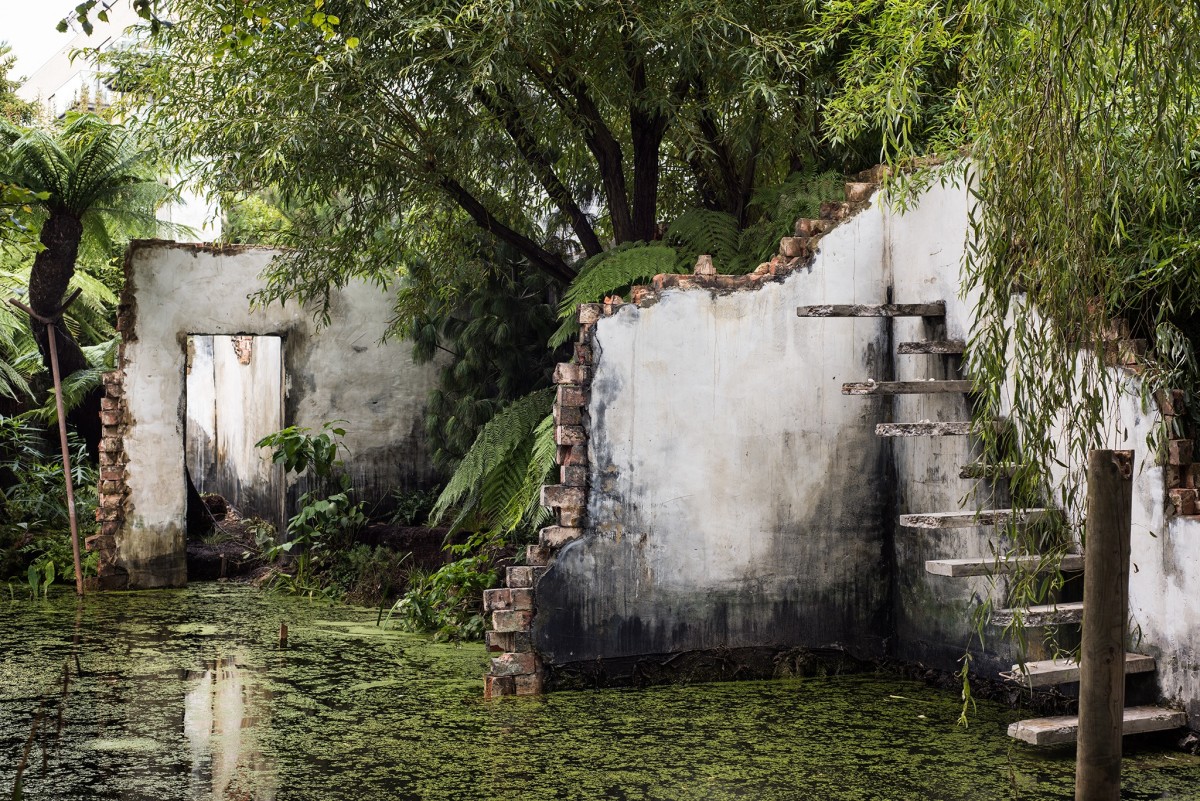But 2016 hasn’t been terrible for art in London, we’ve had David Hockney at the Royal Academy, Georgia O’Keefe at the Tate, William Eggleston at The National Portrait Gallery and there is still time to see some great art in a great city. Here are our picks.
Alex Hartley “After You Left” at Victoria Miro gallery November 19 — December 16

Alex Hartley, A Gentle Collapsing II, 2016 (detail). Installed in Victoria Miro's waterside garden. Photography: Thierry Bal. Courtesy Victoria Miro Gallery.
For those brave enough to face the sub zero temperatures that are currently engulfing London, British artist Alex Hartley has created a major waterside architectural scape into the canals running behind Victoria Miro’s Old Street gallery. A Gentle Collapsing IItransforms the gallery’s canal-side garden into a poetic scene of decay, with Modernist architecture melting into nature. The site-specific installation is accompanied by a series of new work incorporating photography and painting.
"Infinite Mix" at the Hayward Gallery/The Store September 9 — December 11

Cameron Jamie, Massage the History. (2007–9) Courtesy Hayward Gallery and The Store.
It might sound like the name given to a dubious night out in a provincial student union by a bored marketing team, but actually, it is probably one of the most unanimously praised exhibitions of 2016; recently announcing an extension of its running period in light of its success. Whilst the Hayward Gallery on London’s South Bank is currently undergoing a £25 million revamp, big brutalist The Storeis hosting "Infinite Mix", a contemporary sound and video exhibition that seems to have restored many people’s faith in the audiovisual as an artistic medium. Curated by Ralph Rugoff, the exhibition includes work by Martin Creed, Stan Douglas, Jeremy Deller and Cecilia Bengolea, Cyprien Gaillard, Dominique Gonzalez-Foerster, Cameron Jamie, Kahlil Joseph, Elizabeth Price, Rachel Rose and Ugo Rondinone.
Bedwyr Williams “The Gulch” at The Curve, The Barbican Centre September 29 — January 8
.jpg)
Bedwyr Williams “The Gulch” at The Curve, The Barbican Centre. Courtesy The Barbican Centre.
For Welsh artist Bedwyr Williams’ first institutional solo show, he transforms the Barbican’s 90-metre Curve gallery into an immersive theatrical installation. The Gulch is a weird and wonderful foray into the mind of Williams, where we encounter a pair of singing running shoes, a depressed hypnotist and a talking goat. Guiding us through the absurd and the mind-numbingly banal, Williams is witty and intelligent, commenting on cultural snobbery and elevating minute observations.
Azadeh Razaghdoost “Recipe for a Poem” Sophia Contemporary Gallery November 11 — February 18

Installation view of Azadeh Razaghdoost, “Recipe for a Poem” at Sophia Contemporary Gallery. Courtesy Sophia Contemporary Gallery.
Recently-opened Sophia Contemporary Gallery in Mayfair is currently exhibiting 15 new works by Iranian artist Azadeh Razaghdoost. For her first solo exhibition in the UK Razaghdoost’s work is inspired by Romantic poetry of the 19th century in Europe, with a special emphasis on William Blake’s The Sick Rose and Baudelaire’s Fleurs du Mal. Born in Tehran in 1979 Razaghdoost’s practice is principally rooted in Painting, with the colour red tying together this series of work, evoking love, passion and blood.
Abstract Expressionism at the Royal Academy September 24 — January 2

Jackson Pollock, Blue Poles. (1952) Courtesy The Royal Academy of Arts.
Sticking with our theme of “an age of anxiety” we look back to Abstract Expressionism, a movement that emerged from the anguish of the post war years, where artists including Pollock, Rothko and de Kooning broke from convention and reinvented painting. This survey at the Royal Academy is the first in the UK since 1959 and neatly presents the evolution of the movement, making a conscious effort to bring forward oft-overlooked artists of the Abstract Expressionism period, yet ensuring that the most canonical pieces are also all in attendance. Enchanting and energetic, there is something redemptive about this exhibition.









